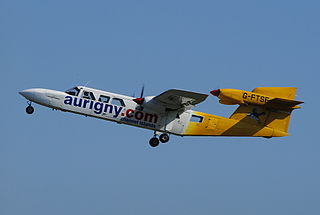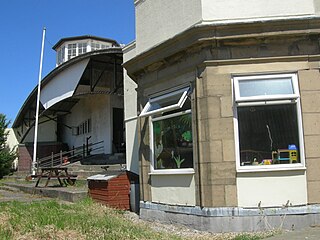The Societé anonyme belge d'Exploitation de la Navigation aérienne, better known by the acronym Sabena or SABENA, was the national airline of Belgium from 1923 to 2001, with its base at Brussels National Airport. After its bankruptcy in 2001, SN Brussels Airlines was formed through a takeover of former subsidiary Delta Air Transport and took over part of Sabena's assets in February 2002, which became Brussels Airlines after a merger with Virgin Express in March 2007. The airline's corporate headquarters were located in the Sabena House on the grounds of Brussels Airport in Zaventem.

The Britten-Norman Trislander is an 18-seat three-engined piston-powered civilian utility aircraft produced in the 1970s and early 1980s by Britten-Norman of Britain. These STOL capable aircraft were produced on the Isle of Wight. They were also produced in Romania, and delivered via Belgium to Britain for their certification. A number of commuter airlines operated the Trislander in scheduled passenger services.

The Westland Wessex is a British-built turbine-powered development of the Sikorsky H-34. It was developed and produced under licence by Westland Aircraft. One of the main changes from Sikorsky's H-34 was the replacement of the piston-engine powerplant with a turboshaft engine. Early models were powered by a single Napier Gazelle engine, while later builds used a pair of de Havilland Gnome engines.

The Westland Wasp is a small 1960s British turbine powered, shipboard anti-submarine helicopter. Produced by Westland Helicopters, it came from the same P.531 programme as the British Army Westland Scout, and is based on the earlier piston-engined Saunders-Roe Skeeter. It fulfilled the requirement of the Royal Navy for a helicopter small enough to land on the deck of a frigate and carry a useful load of two homing torpedoes.

The Westland Lysander is a British army co-operation and liaison aircraft produced by Westland Aircraft that was used immediately before and during the Second World War.

The de Havilland DH.89 Dragon Rapide is a 1930s short-haul biplane airliner developed and produced by British aircraft company de Havilland. Capable of accommodating 6–8 passengers, it proved an economical and durable craft, despite its relatively primitive plywood construction.

The Handley Page Hinaidi was one of two twin-engine bombers built by Handley Page that served with the Royal Air Force between 1925 and 1935. The aircraft was developed from the Handley Page Hyderabad and named after Hinaidi, an RAF station in Iraq.

The Savoia-Marchetti S.73 was an Italian three-engine airliner that flew in the 1930s and early 1940s. The aircraft entered service in March 1935 with a production run of 48 aircraft. Four were exported to Belgium for SABENA, while seven others were produced by SABCA. The main customer was the Italian airline Ala Littoria.

The Avro Type 688 Tudor was a British piston-engined airliner based on Avro's four-engine Lincoln bomber, itself a descendant of the famous Lancaster heavy bomber, and was Britain's first pressurised airliner. Customers saw the aircraft as little more than a pressurised DC-4, and few orders were forthcoming, important customers preferring to buy US aircraft. The tailwheel undercarriage layout was also dated and a disadvantage.

The Handley Page W.8, W.9 and W.10 were British two- and three-engine medium-range biplane airliners designed and built by Handley Page.

The Westland Wapiti was a British two-seat general-purpose military single-engined biplane of the 1920s. It was designed and built by Westland Aircraft Works to replace the Airco DH.9A in Royal Air Force service.

The de Havilland DH.50 was a 1920s British large single-engined biplane transport built by de Havilland at Stag Lane Aerodrome, Edgware, and licence-built in Australia, Belgium, and Czechoslovakia.

The Spartan Cruiser was a 1930s British three-engined transport monoplane for 6 to 10 passengers built by Spartan Aircraft Limited at East Cowes, Isle of Wight. It was a development of the Saro-Percival Mailplane for passenger use.

The Airspeed AS.4 Ferry was three-engined ten-seat biplane airliner designed and built by the British aircraft manufacturer Airspeed Limited. It was the company's first powered aircraft to be produced.

The Westland Westminster was a British helicopter of the 1950s from Westland Aircraft. A large cargo design, it was powered by two turboshaft engines driving a single, five-bladed rotor. Initially unclad, the all-metal airframe was later enclosed in a fabric covering. Designed and built as a private venture without government assistance, it was cancelled when Westland took over rival helicopter producers and their more advanced projects.

The Saro Cloud was a British passenger amphibian flying boat designed and built by Saunders-Roe as the A.19. It was later produced as the A.29 for the Royal Air Force for pilot and navigator training.

Stanley Park Aerodrome was an airfield located in the Stanley Park area of Blackpool, Lancashire, England. It was also known as Blackpool Municipal Airport, and was in use for civil and military flying from 1929 until closure of the airfield in 1947. The site is now used by Blackpool Zoo.

The Avro 642 Eighteen was a 1930s British monoplane airliner. Only two were built — one twin-engined and the other four-engined.

Cobham Air Routes was a 1930s British airline formed in 1935 to operate a service between Croydon and the Channel Islands. Following the loss of an aircraft in a fatal accident the airline was sold to Olley Air Service.
The S.A.B.C.A. S.XII or S.A.B.C.A S.12 was a four-passenger light transport aircraft with three engines and a high wing, built in Belgium in the early 1930s.



















